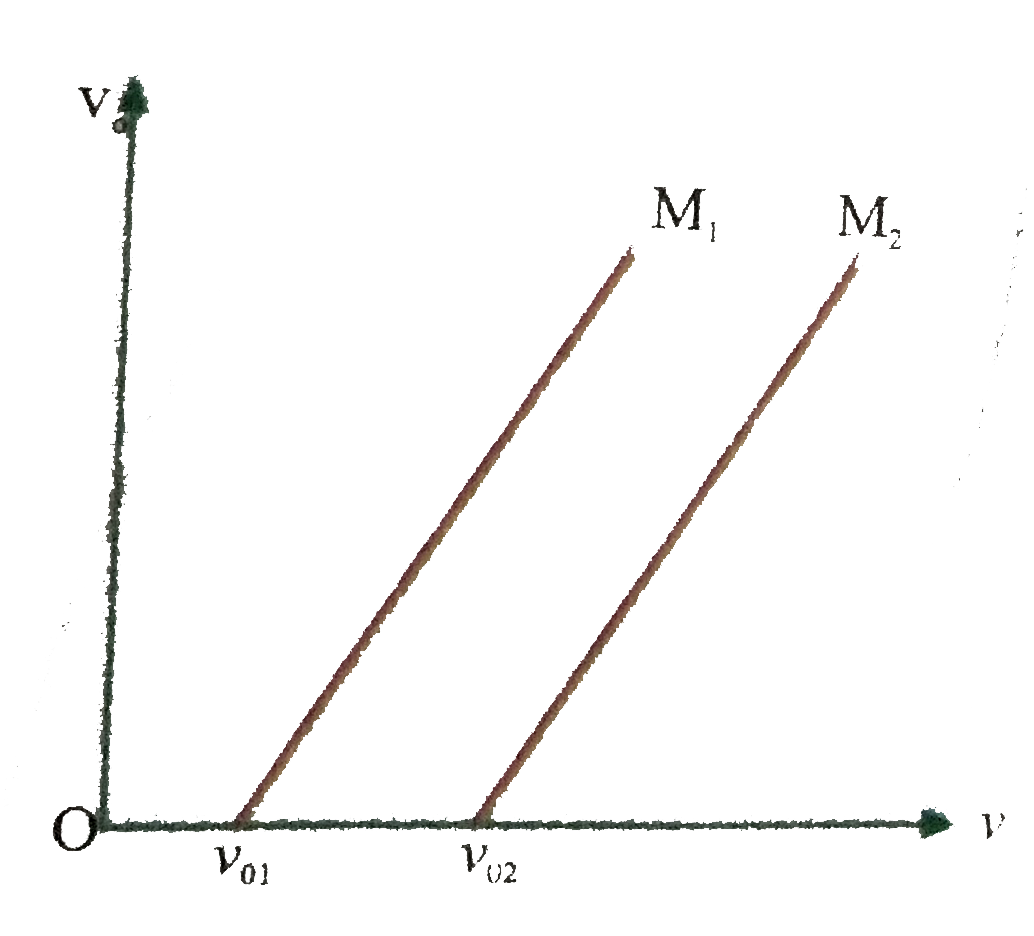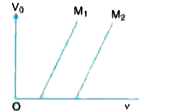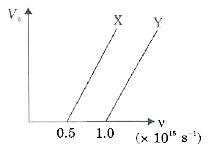The stopping potential (v0) varies linearly with the frequency (v)of the incident radiation for a given photosensitive surface with the slope remaining the same for different surface . Given reason.
To solve the question regarding the linear relationship between stopping potential v0 and frequency ν of incident radiation for a given photosensitive surface, we can follow these steps:
1. Understand the Photoelectric Effect: The photoelectric effect describes the emission of electrons from a material when it is exposed to light (or electromagnetic radiation). The energy of the incident photons is given by E=hν, where h is Planck's constant and ν is the frequency of the radiation.
Hint: Recall that the energy of a photon is directly proportional to its frequency.
2. Relate Energy to Stopping Potential: When light of frequency ν strikes a photosensitive surface, the maximum kinetic energy KEmax of the emitted electrons can be expressed as:
KEmax=hν−ϕ
where ϕ is the work function of the material.
Hint: The work function ϕ is the minimum energy required to remove an electron from the surface of the material.
3. Express Stopping Potential: The stopping potential v0 is related to the maximum kinetic energy of the emitted electrons by the equation:
KEmax=ev0
where e is the charge of an electron. Therefore, we can equate the two expressions:
ev0=hν−ϕ
Hint: Remember that the stopping potential is a measure of the energy required to stop the emitted electrons.
4. Rearranging the Equation: Rearranging the equation gives:
v0=heν−ϕe
This equation shows that v0 is a linear function of ν with a slope of he and a y-intercept of −ϕe.
Hint: Identify the slope and intercept in the linear equation format y=mx+c.
5. Slope Consistency Across Different Surfaces: The slope he remains constant for different photosensitive surfaces because Planck's constant h and the charge of the electron e are universal constants. However, the work function ϕ varies from one material to another, which affects the y-intercept but not the slope.
Hint: Consider how the properties of different materials affect the work function but not the fundamental constants involved.
Conclusion:
The stopping potential v0 varies linearly with the frequency ν of the incident radiation due to the linear relationship established by the photoelectric effect equation. The slope remains the same for different surfaces because it depends only on fundamental constants, while the work function varies with the material.
KEmax=hν−ϕ
where ϕ is the work function of the material.
KEmax=ev0
where e is the charge of an electron. Therefore, we can equate the two expressions:
ev0=hν−ϕ
v0=heν−ϕe
This equation shows that v0 is a linear function of ν with a slope of he and a y-intercept of −ϕe.
The stopping potential v0 varies linearly with the frequency ν of the incident radiation due to the linear relationship established by the photoelectric effect equation. The slope remains the same for different surfaces because it depends only on fundamental constants, while the work function varies with the material.
Topper's Solved these Questions
- BOOK - MODERN PUBLICATIONCHAPTER - DUAL NATURE OF RADIATION AND MATTER EXERCISE - Revision Exercises (Long Answer Questions)3videos
DUAL NATURE OF RADIATION AND MATTER
- BOOK - MODERN PUBLICATIONCHAPTER - DUAL NATURE OF RADIATION AND MATTER EXERCISE - Revision Exercises (Numerical Problems)20videos
DUAL NATURE OF RADIATION AND MATTER
- BOOK - MODERN PUBLICATIONCHAPTER - DUAL NATURE OF RADIATION AND MATTER EXERCISE - Revision Exercises (Fill in the Blanks)11videos
DUAL NATURE OF RADIATION AND MATTER
- BOOK - MODERN PUBLICATIONCHAPTER - CURRENT ELECTRICITYEXERCISE - Chapter Practice Test15videos
CURRENT ELECTRICITY
- BOOK - MODERN PUBLICATIONCHAPTER - ELECTRIC CHARGES AND FIELDS EXERCISE - Chapter Practice Test15videos
ELECTRIC CHARGES AND FIELDS
Similar Questions
Explain giving reasons for the following:
(a) Photoelectric current in a photocell increases with the increase in the intensity of the incident radiation.
(b) The stopping potential (V0) varies linearly with the frequency (v) of the incident radiation for a given photosensitive surface with the slope remaining the same for different surfaces.
(c) Maximum kinetic energy of the photoelectrons is independent of the intensity of incident radiation.View SolutionExplain giving reasons for the following :
(a) Photoelectric current in a photocell increases with the increases in intensity of the incident radiation.
(b) The stopping potential (V0) varries linearly with the frequency (v) of the incident radiation for a given photosenstive surface with the stop remaining the same for different surfaces.
(c) Maximum kinetic energy of the photoelectrons is independent of the intensity of incident radiation.View Solution
Knowledge Check
- Question 1 - Select One
Figure show the variation of the stopping potential (V0) with the frequency (v) of the incident radiations for two different photosensitive matererial M1 and M2 What are the values of work functions for M1 and M2 respectively
 Ahv01,hv02Bhv02,hv01Chv01,hv01Dhv02,hv02
Ahv01,hv02Bhv02,hv01Chv01,hv01Dhv02,hv02 - Question 2 - Select One
The slope of frequency of incident light and stopping potential for a given surface will be
AhBh/eCehDe - Question 3 - Select One
The stopping potential as a function of the frequency of the incident radiation is plotted for two different photoelectric surfaces A and B . The graphs show that work function of A is
 AGreater than that of BBSmaller than that of BCEqual to that of BDNo inference can be drawn about their work functions from the given graphs
AGreater than that of BBSmaller than that of BCEqual to that of BDNo inference can be drawn about their work functions from the given graphs
Plot a graph showing variation of stopping potential (V0) with the frequency (v) of the incident radiation for a given photosensitive material. Hence, state the significance of the threshold frequency in photoelectric emission.
Using the principle of energy conservation, write the equation relating the energy of incident photon, threshold frequency and the maximum kinetic energy of the emitted photoelectrons.View SolutionThe variation of the stopping potential (V0) with the frequency (v) of the light incident on two different photosensitive surfaces M1andM2 is shown in the figure. Identify the surfaces which has greater value of the work function.
 View Solution
View SolutionThe following graph shows the variation of stopping potential V0 with the frequency v of the incident radiation for two photosensitive metals X and Y.
(i) Which metal has larger threshold wavelength ? Give reason.
(ii) Explain giving reason , which metal gives out electrons , having larger kinetic energy , for same wavelength of the incident radiation.
(iii) If the distance between the light source and metal X is halved , how will the kinetic energy of electrons emitted from it change ? Given reason.
 View Solution
View SolutionThe figure shows the variation of stopping potential VQ with the frequency v of the incident radiations for two photosensitive metals P and
Which metal has smaller threshold wavelength ? Justify your answer.View SolutionWhich of the following is the graph between the frequency (v) of the incident radiations and the stopping potential ?
View Solution

